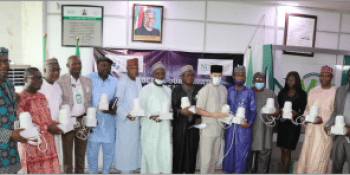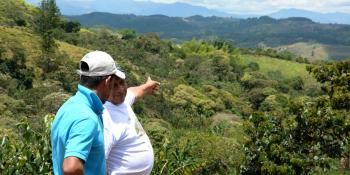Scaling digital agriculture to leapfrog adaptation pathways

6 steps to scale digital agriculture solutions and help countries adapt to climate change
Agriculture is way behind other sectors in the application of information and communication technologies
Digitization of agriculture can play a key role in enabling the agricultural sector to leapfrog traditional development pathways. It can also enable farmers to make their livelihoods profitable and resilient to climate change impacts. Why? Even in developed countries like the United States, agriculture is way behind other sectors in the application of information and communication technologies. At the same time, we are seeing an increasingly connected rural population, with over two-thirds of the global population having a mobile phone, many in rural areas. If we can tap into the dual opportunity of an unexploited market offered by the sector, and the increased connectivity, we may be able to transform agriculture under climate change.
Digital agriculture involves using a range of technologies, channels, and analytic capabilities to make farming more precise, productive, and profitable. For example, advisories combining market and climate information provided to farmers on their mobile phones enable better informed decisions in Ghana. On the other hand, data collected from farmers can be aggregated and analysed, to inform adaptation planning across landscapes and regions, as practised in Colombia. Digital agriculture thus provides an opportunity to drive systemic change in the sector.
How can this be achieved? The National Adaptation Plans (NAPs) process under the United Nations Framework Convention on Climate Change (UNFCCC) offers a major opportunity. Countries are in the process of developing, elaborating and implementing their NAPs, and digital agriculture can be part of their efforts. This was the topic of discussion at a session hosted by the CGIAR Research Program on Climate Change, Agriculture and Food Security (CCAFS) at the NAP Expo 2019 in Songdo, Republic of Korea. The session brought together representatives from the Food and Agriculture Organization of the United Nations (FAO), Global Green Growth Institute (GGGI), Green Climate Fund (GCF), International Crops Research Institute for the Semi-Arid Tropics (ICRISAT), and the World Resources Institute (WRI), to discuss opportunities to leverage digital agriculture in the NAPs.
How can we scale digital agriculture solutions to help countries adapt to climate change?
The discussions at our event identified 6 key steps:
- Connect the unconnected: While a growing number of rural people are getting connected, gaps still exist, especially in accessing the internet and tools available. As a first step, efforts should be made to improve connectivity among the unconnected.
- Get sustained, personalized information services to farmers: The research for development community, including national and international players can play an important role in delivering information to farmers.
- Demonstrate the business case: While the case for digital agriculture in terms of development and adaptation outcomes is strong, this needs to be complemented by a strong business case, to enable investors to support actions at scale.
- Create a conducive enabling environment: A conducive enabling environment, which includes favourable adaptation, agriculture and information and communications technology policies will be key for businesses to thrive.
- Achieve scale: Digital agriculture can help deploy solutions at scale considering specific contexts and personalizing solutions to specific farmers. For example, in Ghana, Esoko has taken a Public-Private Partnership (PPP) business model, which has enabled the program to reach 274,321 beneficiaries.
- Measure and monitor progress: Measuring and monitoring adaptation is knowledge intensive, and digital tools can help make these efforts simpler and cost efficient.
What are the key bottlenecks to achieve scale with digital agriculture?
Firstly, there is a need to improve access and curation of data. Secondly, agriculture needs to become a viable business – so farmers can pay for services and turn that into gains on the market. Thirdly, we need to ensure that the digital era does not bring more inequality. This includes bringing down the costs of digital tools and training individuals and farmers so that not only a few benefit from these opportunities. Lastly, there is a fine line between transparency (sharing codes) and at the same time making sure that there are markets for these data innovations, this needs to be addressed.
Towards a digital revolution in agriculture under climate change
We need nothing short of a digital revolution in the sector
The World Economic Forum has said that we are at the brink of the fourth industrial revolution, where technologies fuse the physical, digital and biological worlds. How can we make this work for agriculture? We need nothing short of a digital revolution in the sector. This can be done through clear policy and leadership that consider the whole agricultural value chain. This needs to be complemented with strategic partnerships between: science, farmers, private sector service providers, extension services and policy. Greater attention is also needed in research to some of the likely technologies that will transform agriculture and food systems. The NAPs process offers an opportunity to bring these stakeholders together to enable the implementation of digital agriculture solutions at scale to help farmers adapt to climate change.
Dhanush Dinesh is the Global Policy Engagement Manager for CCAFS. Ana Maria Loboguerrero is the Head of Global Policy Research for CCAFS.




